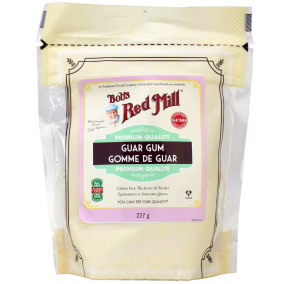Bob's Red Mill Guar Gum, 226g
Guar Gum is a flour-like substance made from the seed of a plant native to Southeast Asia. Use small amounts as a thickener and emulsifier for sauces and dressings, or as a binder and volume enhancer for baked goods. It is a popular ingredient for gluten free scratch baking.
Guar Gum VS Xanthan Gum
If you are new to gluten free baking you may find yourself wondering, “What is the difference between Xanthan Gum and Guar Gum?” Both ingredients are frequently called for in gluten-free recipes and can seem exotic at first, but they both serve the same general purpose as thickeners and emulsifiers. Quite simply, both these ingredients help keep your mixes mixed. They keep oil droplets from sticking together and separating, and solid particles from settling to the bottom. You can use just one or the other; or sometimes for the best results, you can use them in combination together. With the right guidance, gluten-free cooking can be made very easy and enjoyable.
In conventional recipes containing wheat, rye, barley, or triticale flour, the protein gluten in these flours serves the same purpose that guar gum and xanthan gum do in gluten-free baking. Gluten protein is what traditional recipes rely on as a thickening agent to thicken dough and batters and trap air bubbles to make your baked goods light and fluffy. Xanthan gum tends to help starches combine to trap air, while guar gum helps keep large particles suspended in the mix.
One of the differences between the two products is where they come from. Guar gum is made from a seed native to tropical Asia, while xanthan gum is made by a micro organism called Xanthomonas Campestris.
In the kitchen, there are also important differences in using xanthan gum vs. guar gum when creating gluten-free foods. In general, guar gum is good for cold foods such as ice cream or pastry fillings, while xanthan gum is better for baked goods. Xanthan gum is the right choice for yeasted breads. Foods with a high acid content (such as lemon juice) can cause guar gum to lose its thickening abilities. For recipes involving citrus, you will want to use xanthan gum or increase the amount of guar gum used.
In general, it is best to add both xanthan and guar gum to the oil component in a recipe, making complete mix of oil and gum before adding to the rest of liquid ingredients. Using a blender or a food processor is a great way to get the gums to dissolve properly.
The final difference between the two gums is the variation in quantities you will need for different foods. There are no hard and fast rules as to how to combine the two gums together, you’ll have to experiment yourself to see what works best in your recipes.
If you decide to use just one or the other, here are some helpful measurements for popular foods:
How much Xanthan Gum for Gluten Free Baking?
Cookies………………………………¼ teaspoon per cup of flour
Cakes and Pancakes………………..½ teaspoon per cup of flour
Muffins and Quick Breads………… ¾ teaspoon per cup of flour
Breads……………………………….1 to 1-½ tsp. per cup of flour
Pizza Dough…………………..…… 2 teaspoons per cup of flour
For Salad Dressings…Use ½ tsp. Xanthan Gum per 8 oz. of liquid.
How much Guar Gum for Gluten Free Baking?
Cookies………………………………¼ to ½ tsp. per cup of flour
Cakes and Pancakes………………..¾ teaspoon per cup of flour
Muffins and Quick Breads………….1 teaspoon per cup of flour
Breads……………………………….1-½ to 2 tsp. per cup of flour
Pizza Dough…………………..…….1 Tablespoon per cup of flour
For Hot Foods (gravies, stews , heated pudding)…Use 1-3 teaspoons per one quart of liquid.
For Cold Foods (salad dressing, ice creams, pudding) Use about 1-2 teaspoons per quart of liquid.







